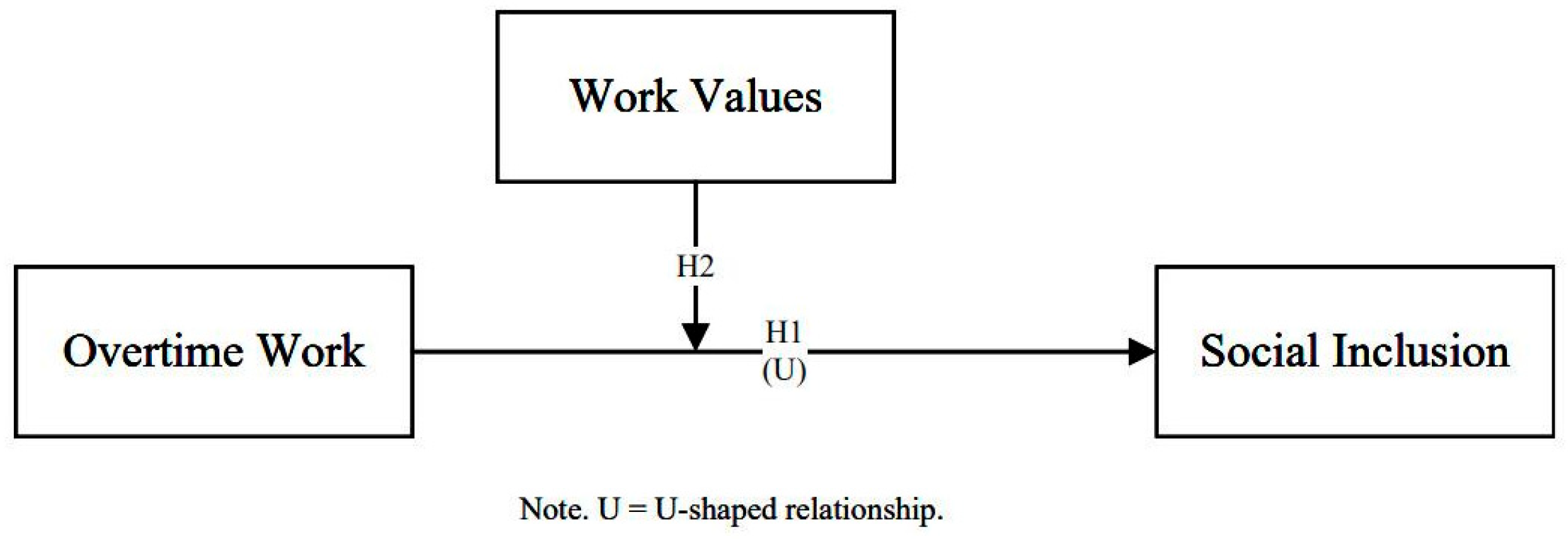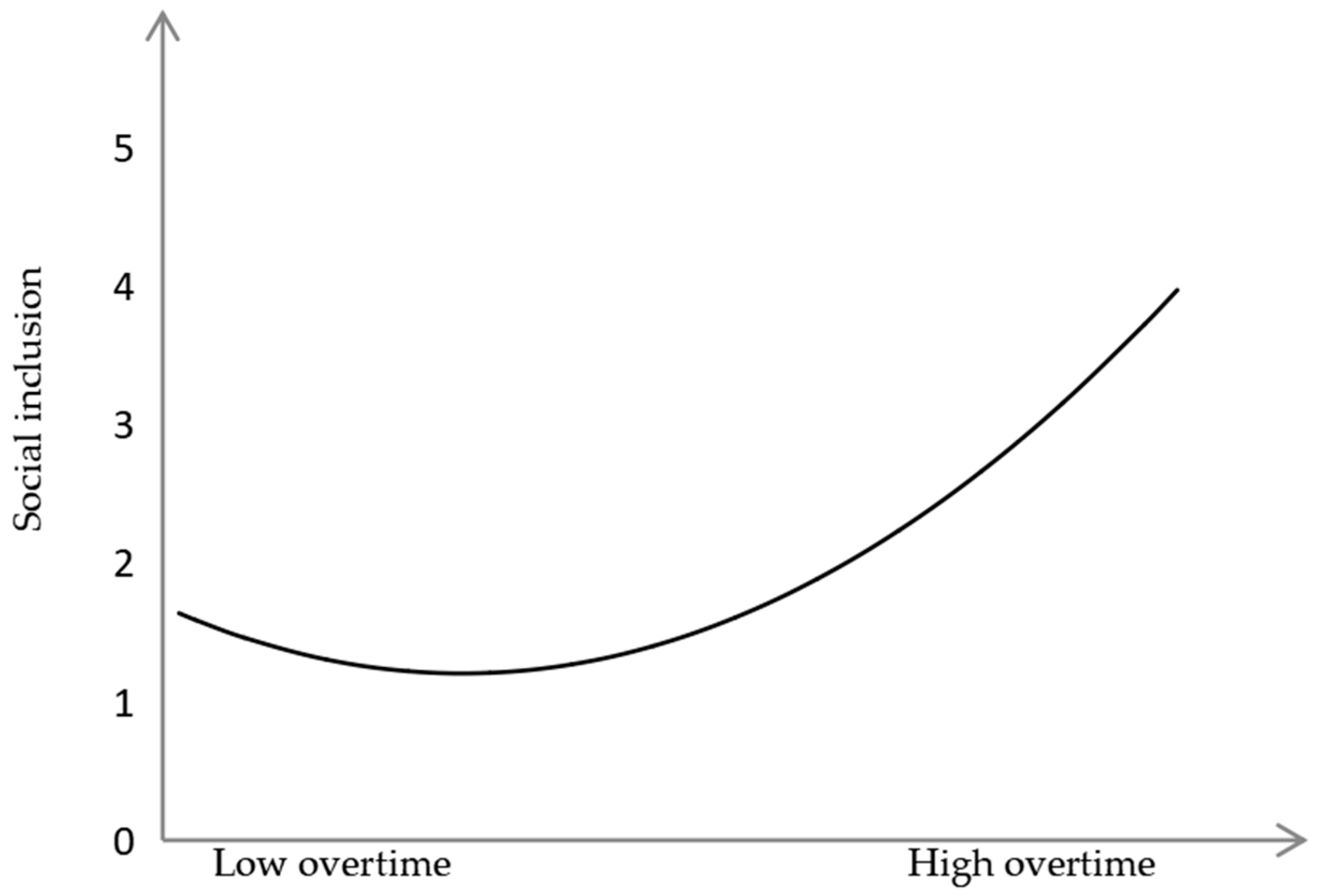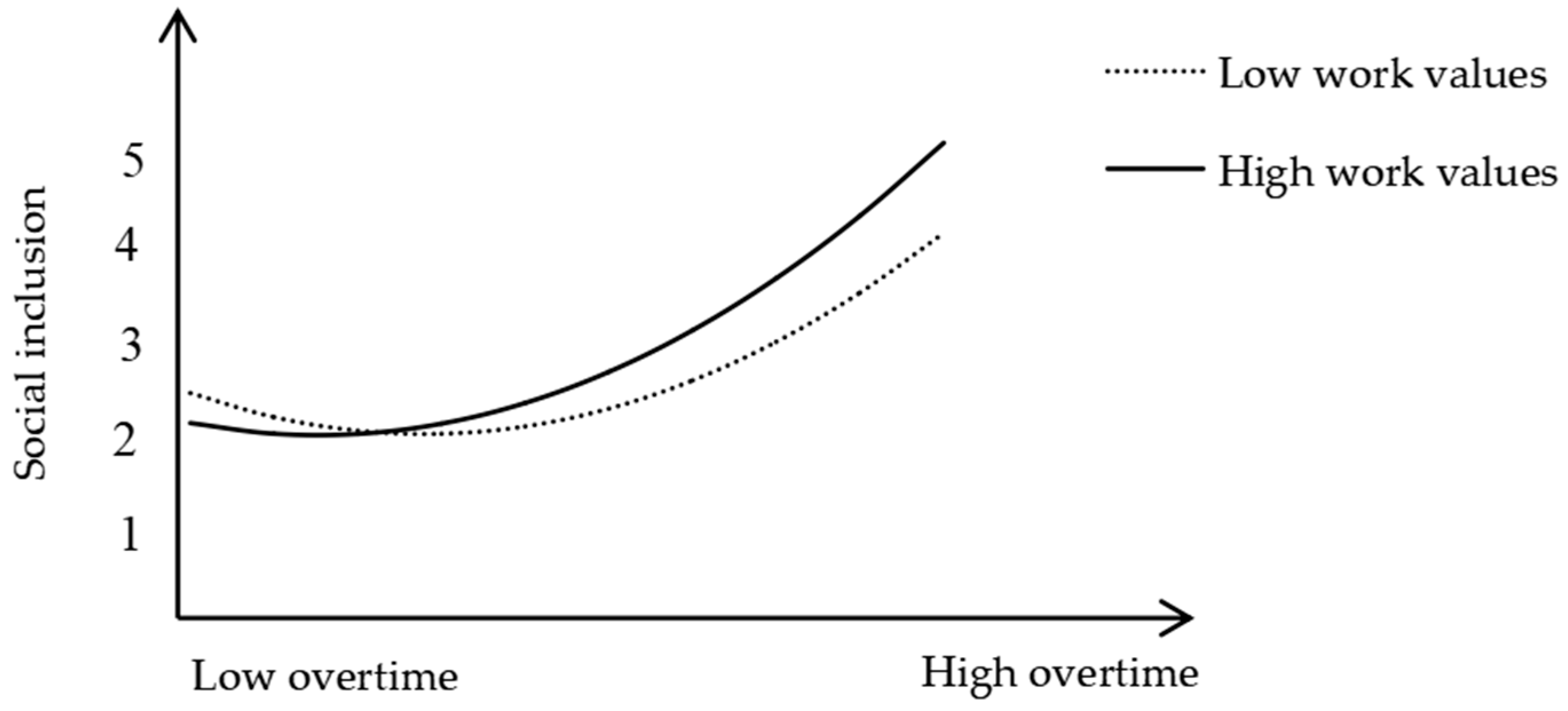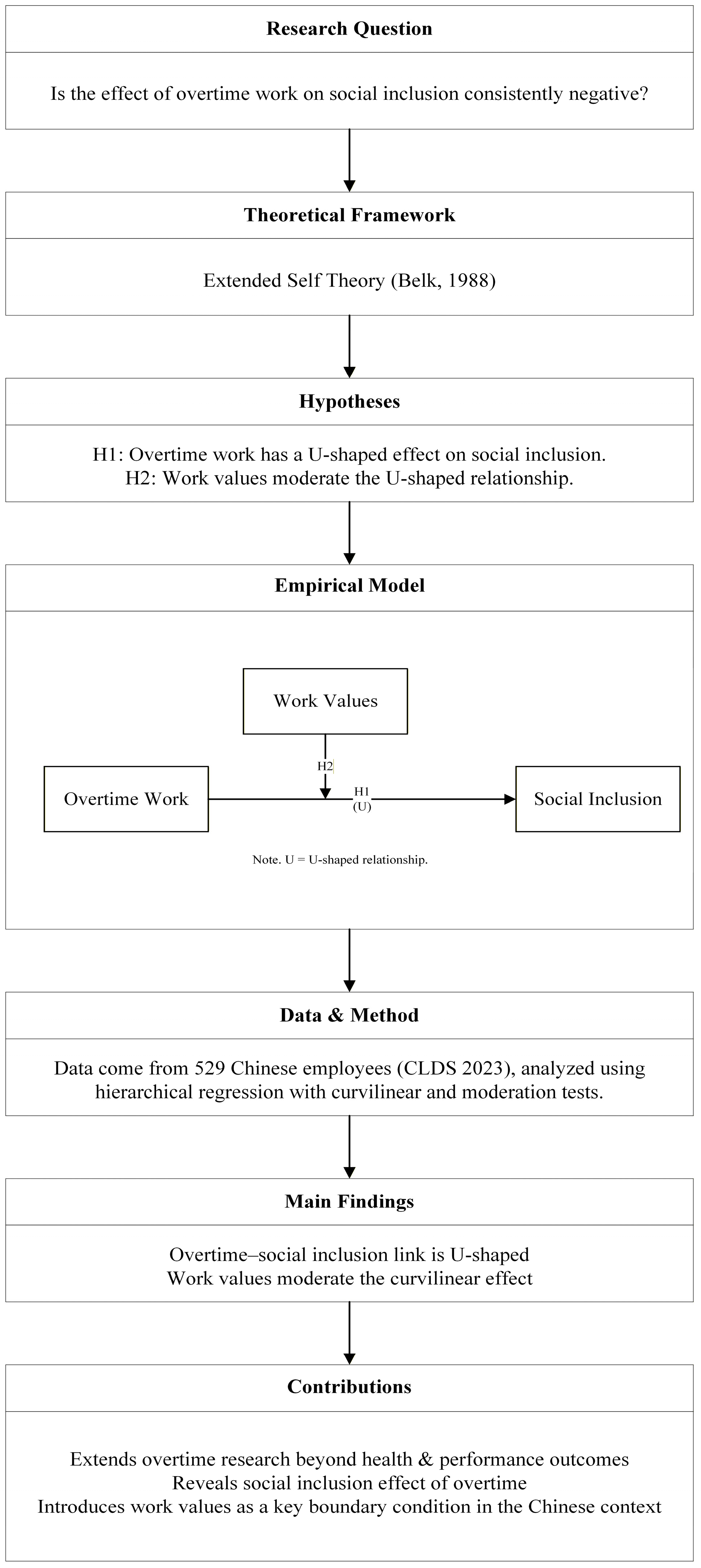Climbing Back up: A U-Shaped Overtime–Inclusion Curve Contingent on Work Values—Evidence from China
Abstract
1. Introduction
2. Theoretical Framework and Hypotheses Development
2.1. Theoretical Framework: Extended-Self Theory
2.2. Overtime Work and Social Inclusion
2.3. Moderating Impact of Work Values
3. Materials and Methods
3.1. Data Source and Description
3.2. Measures
3.3. Data Analysis Method and Model Estimation
4. Results
Hypothesis Testing
5. Discussion
5.1. Key Findings and Contributions
5.2. Cultural Context and Theoretical Extensions
5.3. Implications
5.3.1. Theoretical Implications
5.3.2. Practical Implications
6. Conclusions
7. Research Limitations and Future Research Directions
Author Contributions
Funding
Institutional Review Board Statement
Informed Consent Statement
Data Availability Statement
Conflicts of Interest
References
- Niedhammer, I.; Pineau, E.; Bertrais, S. Employment factors associated with long working hours in France. Saf. Health Work 2023, 14, 483–487. [Google Scholar] [CrossRef]
- Estevão, M.M.; Sá, F. The 35-hour workweek in France: Straightjacket or welfare improvement? Econ. Policy 2008, 23, 418–463. [Google Scholar] [CrossRef]
- Özcan, K.M.; Üçdoğruk Birecikli, Ş.; Ünlü, M.; Öktem Özgür, A. Economic and demographic determinants of overtime in the Turkish private sector. Int. J. Work. Cond. 2021, 22, 1–19. [Google Scholar] [CrossRef]
- International Labour Organization; Committee of Experts on the Application of Conventions and Recommendations. General Survey Concerning Working-Time Instruments: Ensuring Decent Working Time for the Future; Report III (Part B), 107th Session, International Labour Conference; International Labour Office: Geneva, Switzerland, 2018; ISBN 978-92-2-128674-5. Available online: https://www.ilo.org/publications/general-survey-concerning-working-time-instruments-ensuring-decent-working (accessed on 8 November 2025).
- Kuwahara, K.; Minoura, A.; Shimada, Y.; Kawai, Y.; Fukushima, H.; Kondo, M.; Sugiyama, T. Work hours, appraisal at work, and intention to leave the medical research workforce in Japan. J. Occup. Health 2025, 67, uiaf044. [Google Scholar] [CrossRef]
- National Bureau of Statistics of China. National Time Use Survey Bulletin; China Statistics Press: Beijing, China, 2019. (In Chinese)
- Ministry of Foreign Affairs of the People’s Republic of China. China’s National Plan on Implementation of the 2030 Agenda for Sustainable Development. 2016. Available online: https://www.greenpolicyplatform.org/national-documents/chinas-national-plan-implementation-2030-agenda-sustainable-development (accessed on 8 November 2025).
- Bannai, A.; Tamakoshi, A. The association between long working hours and health: A systematic review of epidemiological evidence. Scand. J. Work. Environ. Health 2014, 40, 5–18. [Google Scholar] [CrossRef]
- Beckers, D.G.; van der Linden, D.; Smulders, P.G.; Kompier, M.A.; Taris, T.W.; Geurts, S.A. Voluntary or involuntary? Control over overtime and rewards for overtime in relation to fatigue and work satisfaction. Work Stress 2008, 22, 33–50. [Google Scholar] [CrossRef]
- Fontinha, R.; Easton, S.; Van Laar, D. Overtime and quality of working life in academics and nonacademics: The role of perceived work-life balance. Int. J. Stress Manag. 2019, 26, 173–183. [Google Scholar] [CrossRef]
- Hsu, Y.Y.; Bai, C.H.; Yang, C.M.; Huang, Y.C.; Lin, T.T.; Lin, C.H. Long hours’ effects on work-life balance and satisfaction. Biomed. Res. Int. 2019, 2019, 5046934. [Google Scholar] [CrossRef]
- Virtanen, M.; Kivimäki, M. Long working hours and risk of cardiovascular disease. Curr. Cardiol. Rep. 2018, 20, 123. [Google Scholar] [CrossRef]
- Wong, K.; Chan, A.H.; Ngan, S.C. The effect of long working hours and overtime on occupational health: A meta-analysis of evidence from 1998 to 2018. Int. J. Environ. Res. Public Health 2019, 16, 2102. [Google Scholar] [CrossRef]
- Bei, L.; Hong, C.; Xin, G. How much is too much? The influence of work hours on social development: An empirical analysis for OECD countries. Int. J. Environ. Res. Public Health 2019, 16, 4914. [Google Scholar] [CrossRef]
- Ko, Y.J.; Choi, J.N. Overtime work as the antecedent of employee satisfaction, firm productivity, and innovation. J. Organ. Behav. 2019, 40, 282–295. [Google Scholar] [CrossRef]
- Hino, A.; Inoue, A.; Mafune, K.; Hiro, H. The effect of changes in overtime work hours on depressive symptoms among Japanese white-collar workers: A 2-year follow-up study. J. Occup. Health 2019, 61, 320–327. [Google Scholar] [CrossRef]
- Caruso, C.C. Negative impacts of shiftwork and long work hours. Rehabil. Nurs. 2014, 39, 16–25. [Google Scholar] [CrossRef]
- Burke, R.J. Working to live or living to work: Should individuals and organizations care? J. Bus. Ethics 2009, 84, 167–172. [Google Scholar] [CrossRef]
- Pearce, J.L.; Randel, A.E. Expectations of organizational mobility, workplace social inclusion, and employee job performance. J. Organ. Behav. 2004, 25, 81–98. [Google Scholar] [CrossRef]
- Saffer, H.; Lamiraud, K. The effect of hours of work on social interaction. Rev. Econ. Househ. 2012, 10, 237–258. [Google Scholar] [CrossRef]
- Bolin, K.; Lindgren, B.; Lindström, M.; Nystedt, P. Investments in social capital—Implications of social interactions for the production of health. Soc. Sci. Med. 2003, 56, 2379–2390. [Google Scholar] [CrossRef]
- Kikuchi, H.; Odagiri, Y.; Ohya, Y.; Nakanishi, Y.; Shimomitsu, T.; Theorell, T.; Inoue, S. Association of overtime work hours with various stress responses in 59,021 Japanese workers: Retrospective cross-sectional study. PLoS ONE 2020, 15, e0229506. [Google Scholar] [CrossRef] [PubMed]
- Putnam, R.D. Bowling alone: America’s declining social capital. J. Democr. 1995, 6, 65–78. [Google Scholar] [CrossRef]
- Kaasa, A.; Parts, E. Individual-level determinants of social capital in Europe: Differences between country groups. Acta Sociol. 2008, 51, 145–168. [Google Scholar] [CrossRef]
- Jack Ma: It’s a Blessing to Work 996. Available online: https://m.sohu.com/a/307487736_115565 (accessed on 8 November 2025).
- Elizur, D.; Borg, I.; Hunt, R.; Beck, I.M. The structure of work values: A cross-cultural comparison. J. Organ. Behav. 1991, 12, 21–38. [Google Scholar] [CrossRef]
- Ros, M.; Schwartz, S.H.; Surkiss, S. Basic individual values, work values, and the meaning of work. Appl. Psychol. Int. Rev. 1999, 48, 49–71. [Google Scholar] [CrossRef]
- Bei, L.; Hong, C.; Xinru, H. Map changes and theme evolution in work hours: A co-word analysis. Int. J. Environ. Res. Public Health 2018, 15, 1039. [Google Scholar] [CrossRef]
- Piasna, A. Scheduled to work hard: The relationship between non-standard working hours and work intensity among European workers (2005–2015). Hum. Resour. Manag. J. 2018, 28, 167–181. [Google Scholar] [CrossRef]
- Fujiwara, T.; Shimazu, A.; Tokita, M.; Shimada, K.; Takahashi, M.; Watai, I.; Iwata, N.; Kawakami, N. Association between parental workaholism and body mass index of offspring: A prospective study among Japanese dual workers. Front. Public Health 2016, 4, 41. [Google Scholar] [CrossRef]
- Wagner-Hartl, V.; Kallus, K.W. Investigation of psychophysiological and subjective effects of long working hours: Do age and hearing impairment matter? Front. Psychol. 2018, 8, 2167. [Google Scholar] [CrossRef]
- Jingyi, C. Research review on overtime issues. Mod. Manag. 2018, 8, 387–394. [Google Scholar] [CrossRef]
- Mucci, N.; Traversini, V.; Giorgi, G.; Tommasi, E.; De Sio, S.; Arcangeli, G. Migrant workers and psychological health: A systematic review. Sustainability 2020, 12, 120. [Google Scholar] [CrossRef]
- Chen, Y.; Li, P.; Yang, C. Examining the effects of overtime work on subjective social status and social inclusion in the Chinese context. Int. J. Environ. Res. Public Health 2020, 17, 3265. [Google Scholar] [CrossRef]
- Ngai, L.R.; Pissarides, C.A. Trends in hours and economic growth. Rev. Econ. Dyn. 2008, 11, 239–256. [Google Scholar] [CrossRef]
- Collewet, M.; Sauermann, J. Working hours and productivity. Labour Econ. 2017, 47, 96–106. [Google Scholar] [CrossRef]
- Cygan-Rehm, K.; Wunder, C. Do working hours affect health? Evidence from statutory workweek regulations in Germany. Labour Econ. 2018, 53, 162–171. [Google Scholar] [CrossRef]
- Hu, N.C.; Chen, J.D.; Cheng, T.J. The associations between long working hours, physical inactivity, and burnout. J. Occup. Environ. Med. 2016, 58, 514–518. [Google Scholar] [CrossRef]
- Belk, R.W. Possessions and the extended self. J. Consum. Res. 1988, 15, 139–168. [Google Scholar] [CrossRef]
- Belk, R.W. Are we what we have? In I Shop Therefore I Am: Compulsive Spending and the Search for Self; Benson, A., Ed.; Jason Aronson Press: Northvale, NJ, USA, 2000; pp. 76–104. [Google Scholar]
- Dittmar, H. The Social Psychology of Material Possessions: To Have Is to Be; Harvester Wheatsheaf: Hemel Hempstead, UK, 1992. [Google Scholar]
- Mattingly, B.A.; McIntyre, K.P.; Lewandowski, G.W., Jr. Approach motivation and the expansion of self in close relationships. Pers. Relatsh. 2012, 19, 113–127. [Google Scholar] [CrossRef]
- Pierce, J.L.; Kostova, T.; Dirks, K.T. The state of psychological ownership: Integrating and extending a century of research. Rev. Gen. Psychol. 2003, 7, 84–107. [Google Scholar] [CrossRef]
- Richins, M.L. Valuing things: The public and private meanings of possessions. J. Consum. Res. 1994, 21, 504–521. [Google Scholar] [CrossRef]
- Pierce, J.L.; Kostova, T.; Dirks, K.T. Toward a theory of psychological ownership in organizations. Acad. Manag. Rev. 2001, 26, 298–310. [Google Scholar] [CrossRef]
- Baumeister, R.F.; Leary, M.R. The need to belong: Desire for interpersonal attachments as a fundamental human motivation. Psychol. Bull. 1995, 117, 497–529. [Google Scholar] [CrossRef]
- Kerr, N.L.; Levine, J.M. The detection of social exclusion: Evolution and beyond. Group Dyn. Theory Res. Pract. 2008, 12, 39–52. [Google Scholar] [CrossRef]
- Wesselmann, E.D.; Butler, F.A.; Williams, K.D.; Pickett, C.L. Adding injury to insult: Unexpected rejection leads to more aggressive responses. Aggress. Behav. 2010, 36, 232–237. [Google Scholar] [CrossRef] [PubMed]
- Wesselmann, E.D.; Wirth, J.H.; Pryor, J.B.; Reeder, G.D.; Williams, K.D. When do we ostracize? Soc. Psychol. Personal. Sci. 2013, 4, 108–115. [Google Scholar] [CrossRef]
- Litwiller, F.; White, C.; Gallant, K.A.; Gilbert, R.; Hutchinson, S.; Hamilton-Hinch, B.; Lauckner, H.; Fenton, L. The benefits of recreation for the recovery and social inclusion of individuals with mental illness: An integrative review. Leis. Sci. 2017, 39, 1–19. [Google Scholar] [CrossRef]
- Dean, J.W.; Brass, D.J. Social interaction and the perception of job characteristics in an organization. Hum. Relat. 1985, 38, 571–582. [Google Scholar] [CrossRef]
- Liu, B.; Chen, H.; Yang, X.; Hou, C. Why work overtime? A systematic review on the evolutionary trend and influencing factors of work hours in China. Front. Public Health 2019, 7, 343. [Google Scholar] [CrossRef] [PubMed]
- Xiao, C.; Silva, E.A.; Zhang, C. Nine-nine-six work system and people’s movement patterns: Using big data sets to analyse overtime working in Shanghai. Land Use Policy 2020, 90, 104340. [Google Scholar] [CrossRef]
- Banerjee, A.V.; Duflo, E. The economic lives of the poor. J. Econ. Perspect. 2007, 21, 141–168. [Google Scholar] [CrossRef]
- Belk, R.W. (Ed.) Possessions and the sense of past. In Highways and Buyways: Naturalistic Research from the Consumer Behavior Odyssey; Association for Consumer Research: Provo, UT, USA, 1991; pp. 114–130. [Google Scholar]
- Grant, A.M.; Berg, J.M.; Cable, D.M. Job titles as identity badges: How self-reflective titles can reduce emotional exhaustion. Acad. Manag. J. 2014, 57, 1201–1225. [Google Scholar] [CrossRef]
- Kahn, W.A. Psychological conditions of personal engagement and disengagement at work. Acad. Manag. J. 1990, 33, 692–724. [Google Scholar] [CrossRef]
- Swann, W.B., Jr.; Polzer, J.T.; Seyle, D.C.; Ko, S.J. Finding value in diversity: Verification of personal and social self-views in diverse groups. Acad. Manag. Rev. 2004, 29, 9–27. [Google Scholar] [CrossRef]
- Schmidt, A.M.; Dolis, C.M. Something’s got to give: The effects of dual-goal difficulty, goal progress, and expectancies on resource allocation. J. Appl. Psychol. 2009, 94, 678–691. [Google Scholar] [CrossRef]
- Proctor, S.P.; White, R.F.; Robins, T.G.; Echeverria, D.; Rocskay, A.Z. Effect of overtime work on cognitive function in automotive workers. Scand. J. Work. Environ. Health 1996, 22, 124–132. [Google Scholar] [CrossRef] [PubMed]
- Schwartz, S.H. A theory of cultural values and some implications for work. Appl. Psychol. Int. Rev. 1999, 48, 23–47. [Google Scholar] [CrossRef]
- Verplanken, B. Value congruence and job satisfaction among nurses: A human relations perspective. Int. J. Nurs. Stud. 2004, 41, 599–605. [Google Scholar] [CrossRef] [PubMed]
- Warr, P. Work values: Some demographic and cultural correlates. J. Occup. Organ. Psychol. 2008, 81, 751–775. [Google Scholar] [CrossRef]
- Sagie, A.; Elizur, D.; Koslowsky, M. Work values: A theoretical overview and a model of their effects. J. Organ. Behav. 1996, 17, 503–514. [Google Scholar] [CrossRef]
- Ryan, R.M.; Deci, E.L. Self-determination theory and the facilitation of intrinsic motivation, social development, and well-being. Am. Psychol. 2000, 55, 68–78. [Google Scholar] [CrossRef]
- Twenge, J.M.; Campbell, S.M.; Hoffman, B.J.; Lance, C.E. Generational differences in work values: Leisure and extrinsic values increasing, social and intrinsic values decreasing. J. Manag. 2010, 36, 1117–1142. [Google Scholar] [CrossRef]
- Spreitzer, G.M.; Porath, C.L. Self-determination as nutriment for thriving: Building an integrative model of human growth at work. In The Oxford Handbook of Work Engagement, Motivation, and Self-Determination Theory; Gagné, M., Ed.; Oxford University Press: New York, NY, USA, 2014; pp. 245–254. [Google Scholar]
- Dirks, K.T.; Cummings, L.L.; Pierce, J.L. Psychological ownership in organizations: Conditions under which individuals promote and resist change. In Research in Organizational Change and Development; Woodman, R.W., Pasmore, W.A., Eds.; JAI Press: Greenwich, CT, USA, 1996; pp. 1–23. [Google Scholar]
- Jin, J.; Rounds, J. Stability and change in work values: A meta-analysis of longitudinal studies. J. Vocat. Behav. 2012, 80, 326–339. [Google Scholar] [CrossRef]
- Martela, F.; Pessi, A.B. Significant work is about self-realization and broader purpose: Defining the key dimensions of meaningful work. Front. Psychol. 2018, 9, 363. [Google Scholar] [CrossRef]
- Saito, Y.; Igarashi, A.; Noguchi-Watanabe, M.; Takai, Y.; Yamamoto-Mitani, N. Work values and their association with burnout/work engagement among nurses in long-term care hospitals. J. Nurs. Manag. 2018, 26, 393–402. [Google Scholar] [CrossRef] [PubMed]
- Chen, C.H.V.; Kao, R.H. Work values and service-oriented organizational citizenship behaviors: The mediation of psychological contract and professional commitment: A case of students in Taiwan Police College. Soc. Indic. Res. 2012, 107, 149–169. [Google Scholar] [CrossRef]
- Tomaževič, N.; Seljak, J.; Aristovnik, A. Occupational values, work climate and demographic characteristics as determinants of job satisfaction in policing. Police Pract. Res. 2019, 20, 376–393. [Google Scholar] [CrossRef]
- Vansteenkiste, M.; Neyrinck, B.; Niemiec, C.P.; Soenens, B.; De Witte, H.; Van den Broeck, A. On the relations among work value orientations, psychological need satisfaction and job outcomes: A self-determination theory approach. J. Occup. Organ. Psychol. 2007, 80, 251–277. [Google Scholar] [CrossRef]
- Center for Social Survey of Sun Yat-sen University. China Labor-force Dynamic Survey. Sci. Data Bank 2023, CSTR: 31253.11.sciencedb.02333. [CrossRef]
- Janssen, O. Fairness perceptions as a moderator in the curvilinear relationships between job demands, and job performance and job satisfaction. Acad. Manag. J. 2001, 44, 1039–1050. [Google Scholar] [CrossRef]
- Bauer, D.J.; Curran, P.J. Probing interactions in fixed and multilevel regression: Inferential and graphical techniques. Multivar. Behav. Res. 2005, 40, 373–400. [Google Scholar] [CrossRef]
- Beckers, D.G.J.; van der Linden, D.; Smulders, P.G.T.; Kompier, M.A.J.; van Veldhoven, M.J.P.; van Yperen, N.W. Working overtime hours: Relations with fatigue, work motivation, and the quality of work. J. Occup. Environ. Med. 2004, 46, 1282–1289. [Google Scholar]
- Golden, L.; Wiens-Tuers, B. Overtime work and wellbeing at home. Rev. Soc. Econ. 2008, 66, 25–49. [Google Scholar] [CrossRef]
- Kalleberg, A.L. Work values and job rewards: A theory of job satisfaction. Am. Sociol. Rev. 1977, 42, 124–143. [Google Scholar] [CrossRef]
- Freeman, R.B. Labor Markets and Institutions in Economic Development. Am. Econ. Rev. 1993, 83, 403–408. Available online: https://www.jstor.org/stable/2117698 (accessed on 8 November 2025).
- Hofstede, G. Culture’s Consequences: Comparing Values, Behaviors, Institutions, and Organizations Across Nations, 2nd ed.; Sage Publications: Thousand Oaks, CA, USA, 2001. [Google Scholar]
- Inglehart, R.; Baker, W.E. Modernization, cultural change, and the persistence of traditional values. Am. Sociol. Rev. 2000, 65, 19–51. [Google Scholar] [CrossRef]
- Van Iddekinge, C.H.; Arnold, J.D.; Aguinis, H.; Lang, J.W.B.; Lievens, F. Work effort: A conceptual and meta-analytic review. J. Manag. 2023, 49, 125–157. [Google Scholar] [CrossRef]
- Anttila, T.; Oinas, T.; Tammelin, M.; Nätti, J. Working-time regimes and work-life balance in Europe. Eur. Sociol. Rev. 2015, 31, 713–724. [Google Scholar] [CrossRef]
- Yang, S.; Chen, L.; Bi, X. Overtime work, job autonomy, and employees’ subjective well-being: Evidence from China. Front. Public Health 2023, 11, 1077177. [Google Scholar] [CrossRef]
- Harvey, F. National cultural differences in theory and practice: Evaluating Hofstede’s national cultural framework. Inf. Technol. People 1997, 10, 132–146. [Google Scholar] [CrossRef]
- Parker, R.S.; Haytko, D.L.; Hermans, C.M. Individualism and collectivism: Reconsidering old assumptions. J. Int. Bus. Res. 2009, 8, 127–136. [Google Scholar]
- Lomas, T.; Diego-Rosell, P.; Shiba, K.; Standridge, P.; Lee, M.T.; Case, B.; VanderWeele, T.J. Complexifying individualism versus collectivism and West versus East: Exploring global diversity in perspectives on self and other in the Gallup World Poll. J. Cross-Cult. Psychol. 2023, 54, 61–89. [Google Scholar] [CrossRef]
- Artazcoz, L.; Cortès, I.; Benavides, F.G.; Escribà-Agüir, V.; Bartoll, X.; Vargas, H.; Borrell, C. Long working hours and health in Europe: Gender and welfare state differences in a context of economic crisis. Health Place 2016, 40, 161–168. [Google Scholar] [CrossRef]
- Arlinghaus, A.; Bohle, P.; Iskra-Golec, I.; Jansen, N.; Jay, S.; Rotenberg, L. Working Time Society consensus statements: Ev-idence-based effects of shift work and non-standard working hours on workers, family and community. Ind. Health 2019, 57, 184–200. [Google Scholar] [CrossRef]
- Kahn, W.A. To be fully there: Psychological presence at work. Hum. Relat. 1992, 45, 321–349. [Google Scholar] [CrossRef]
- Rich, B.L.; Lepine, J.A.; Crawford, E.R. Job engagement: Antecedents and effects on job performance. Acad. Manag. J. 2010, 53, 617–635. [Google Scholar] [CrossRef]
- Wahba, M.A.; Bridwell, L.G. Maslow reconsidered: A review of research on the need hierarchy theory. Organ. Behav. Hum. Decis. Process. 1976, 15, 212–240. [Google Scholar] [CrossRef]
- Basinska, B.A.; Dåderman, A.M. Work values of police officers and their relationship with job burnout and work engagement. Front. Psychol. 2019, 10, 442. [Google Scholar] [CrossRef]
- Li, Z. Economic migration and urban citizenship in China: The role of points systems. Popul. Dev. Rev. 2012, 38, 503–533. [Google Scholar] [CrossRef]
- Trejo, S.J. The effects of overtime pay regulation on worker compensation. Am. Econ. Rev. 1991, 81, 719–740. [Google Scholar]
- Crampton, S.M.; Hodge, J.W.; Mishra, J.M. The FLSA and overtime pay. Public Pers. Manag. 2003, 32, 331–354. [Google Scholar] [CrossRef]
- Kinjerski, V.; Skrypnek, B.J. Creating organizational conditions that foster employee spirit at work. Leadersh. Organ. Dev. J. 2006, 27, 280–295. [Google Scholar] [CrossRef]



| Variable Name | Description |
|---|---|
| Control Variables | |
| Gender | 1 = Male; 2 = Female |
| Age | Years |
| Marriage | Your marital status is: 1 = Unmarried; 2 = First marriage; 3 = Remarried; 4 = Divorced; 5 = Bereaved; 6 = Cohabitation |
| Living type | Your living type is 1 = Rural; 2 = Urban |
| Annual income | Your total income in 2015 was (including agricultural income, wage income, operating income, etc.) RMB (Yuan). |
| Independent Variable | |
| Overtime work | How many hours did you work overtime last month? |
| Dependent variable | |
| Social inclusion | Are you likely to settle here in the future? 1 = Very unlikely; 2 = Less likely; 3 = Not sure; 4 = More likely; 5 = Very likely |
| Moderating variable | |
| Work values | What is the meaning or value of your current job to you? 1 = very inconsistent; 2 = comparatively inconsistent; 3 = indifferent; 4 = relatively consistent; 5 = very consistent |
| Variable | Mean | SD | 1 | 2 | 3 | 4 | 5 | 6 | 7 |
|---|---|---|---|---|---|---|---|---|---|
| 1. Gender | 1.42 | 0.494 | |||||||
| 2. age | 35.70 | 9.594 | −0.095 * | ||||||
| 3. Marriage | 1.86 | 0.781 | −0.013 | 0.402 ** | |||||
| 4. Income (USD) | 7918 | 7937 | −0.165 ** | 0.001 | 0.096 * | ||||
| 5. Unit type | 1.77 | 0.422 | 0.040 | −0.032 | −0.021 | 0.181 ** | |||
| 6. Work values | 3.65 | 0.607 | −0.015 | 0.027 | −0.040 | 0.123 ** | −0.035 | ||
| 7. Hours of overtime | 34.44 | 37.282 | −0.088 * | −0.004 | 0.003 | −0.072 | −0.176 ** | −0.058 | |
| 8. Social inclusion | 3.29 | 1.586 | 0.048 | 0.013 | 0.038 | 0.207 ** | 0.241 ** | 0.106 * | −0.199 ** |
| Variable | Model 1 | Model 2 | Model 3 | Model 4 | Model 5 |
|---|---|---|---|---|---|
| Step 1: Control variable | |||||
| Gender | 0.071 | 0.057 | 0.056 | 0.055 | 0.050 |
| Marriage | 0.018 | 0.020 | 0.023 | 0.029 | 0.023 |
| Age | 0.019 | 0.015 | 0.000 | −0.004 | −0.006 |
| Income | 0.180 ** | 0.171 ** | 0.175 ** | 0.163 ** | 0.161 ** |
| Unit type | 0.206 ** | 0.182 ** | 0.167 ** | 0.173 ** | 0.170 ** |
| Step 2: Independent variable | |||||
| Hours of overtime | −0.149 ** | −0.335 ** | −0.328 ** | −0.335 ** | |
| Step 3: Quadratic term main effects | |||||
| Overtime work squared (OW2) | 0.248 ** | 0.246 ** | 0.257 ** | ||
| Step 4: Moderating variable | |||||
| WV | 0.083 * | 0.078 | |||
| Step 5: Moderation effects | |||||
| OW × WV | 0.165 * | ||||
| OW2 × WV | −0.074 | ||||
| R2 | 0.302 | 0.336 | 0.375 | 0.383 | 0.399 |
| ΔR2 | 0.302 | 0.034 | 0.039 | 0.008 | 0.016 |
| F | 10.514 ** | 11.048 ** | 12.151 ** | 11.198 ** | 9.835 ** |
Disclaimer/Publisher’s Note: The statements, opinions and data contained in all publications are solely those of the individual author(s) and contributor(s) and not of MDPI and/or the editor(s). MDPI and/or the editor(s) disclaim responsibility for any injury to people or property resulting from any ideas, methods, instructions or products referred to in the content. |
© 2025 by the authors. Licensee MDPI, Basel, Switzerland. This article is an open access article distributed under the terms and conditions of the Creative Commons Attribution (CC BY) license (https://creativecommons.org/licenses/by/4.0/).
Share and Cite
Xu, J.; Yang, C. Climbing Back up: A U-Shaped Overtime–Inclusion Curve Contingent on Work Values—Evidence from China. Sustainability 2025, 17, 10075. https://doi.org/10.3390/su172210075
Xu J, Yang C. Climbing Back up: A U-Shaped Overtime–Inclusion Curve Contingent on Work Values—Evidence from China. Sustainability. 2025; 17(22):10075. https://doi.org/10.3390/su172210075
Chicago/Turabian StyleXu, Jiaqi, and Chunjiang Yang. 2025. "Climbing Back up: A U-Shaped Overtime–Inclusion Curve Contingent on Work Values—Evidence from China" Sustainability 17, no. 22: 10075. https://doi.org/10.3390/su172210075
APA StyleXu, J., & Yang, C. (2025). Climbing Back up: A U-Shaped Overtime–Inclusion Curve Contingent on Work Values—Evidence from China. Sustainability, 17(22), 10075. https://doi.org/10.3390/su172210075






